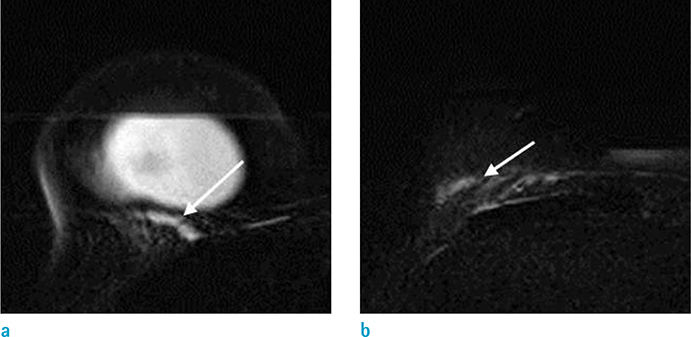Investig Magn Reson Imaging.
2018 Jun;22(2):110-112. 10.13104/imri.2018.22.2.110.
MR Findings of Breast Implant Rupture Presenting with Unusual Breast Enlargement
- Affiliations
-
- 1Department of Radiology, Korea University Guro Hospital, Korea University College of Medicine, Seoul, Korea. wokhee@korea.ac.kr
- 2Department of Plastic Surgery, Korea University Guro Hospital, Korea University College of Medicine, Seoul, Korea.
- KMID: 2415889
- DOI: http://doi.org/10.13104/imri.2018.22.2.110
Abstract
- We report the case of a patient who presented with rupture of a silicone breast implant showing acute and chronic inflammation. Magnetic resonance imaging (MRI) showed silicone foci outside the implant shell and inside the pectoralis muscles that represented intra- and extracapsular ruptures of the implant and silicone granuloma. There were distinct fluid-fluid levels of various signal intensities and no signs of implant collapse such as "˜linguine sign.' Rather, we detected enlargement of both the implant shell and the breast.
MeSH Terms
Figure
Reference
-
1. Grubstein A, Cohen M, Steinmetz A, Cohen D. Siliconomas mimicking cancer. Clin Imaging. 2011; 35:228–231.
Article2. Yang N, Muradali D. The augmented breast: a pictorial review of the abnormal and unusual. AJR Am J Roentgenol. 2011; 196:W451–W460.
Article3. Colombo G, Ruvolo V, Stifanese R, Perillo M, Garlaschi A. Prosthetic breast implant rupture: imaging--pictorial essay. Aesthetic Plast Surg. 2011; 35:891–900.
Article4. Gorczyca DP, Gorczyca SM, Gorczyca KL. The diagnosis of silicone breast implant rupture. Plast Reconstr Surg. 2007; 120:49S–61S.
Article5. Berg WA, Nguyen TK, Middleton MS, Soo MS, Pennello G, Brown SL. MR imaging of extracapsular silicone from breast implants: diagnostic pitfalls. AJR Am J Roentgenol. 2002; 178:465–472.6. Orel SG. MR imaging of the breast. Radiol Clin North Am. 2000; 38:899–913.
Article7. Steinke K, Brook P, Ramuz O. Radiological pitfall: Siliconoma in internal mammary lymph node mimics breast cancer recurrence. Radiol Case Rep. 2011; 6:601.
Article8. Choi JJ, Lee JH, Kang BJ, et al. Clinical and imaging characteristics of Polyimplant Prosthesis hydrogel breast implants. J Comput Assist Tomogr. 2010; 34:449–455.
Article
- Full Text Links
- Actions
-
Cited
- CITED
-
- Close
- Share
- Similar articles
-
- Rupture of Breast Implants after Augmentation Mammoplasty: A Case Report of Simultaneous Intra-extracapsular Rupture
- Mechanical irritation by protruding bone: A possible cause of breast implant rupture
- Understanding Silicone Breast Implant-Associated Complications for Radiologists
- Complication of Augmentation Mammoplasty using Polysaccharide Hydrogel Breast implant: Two Cases Report
- The Reliability of Ultrasonographic Fending of Silicone Breast Implant Rupture



